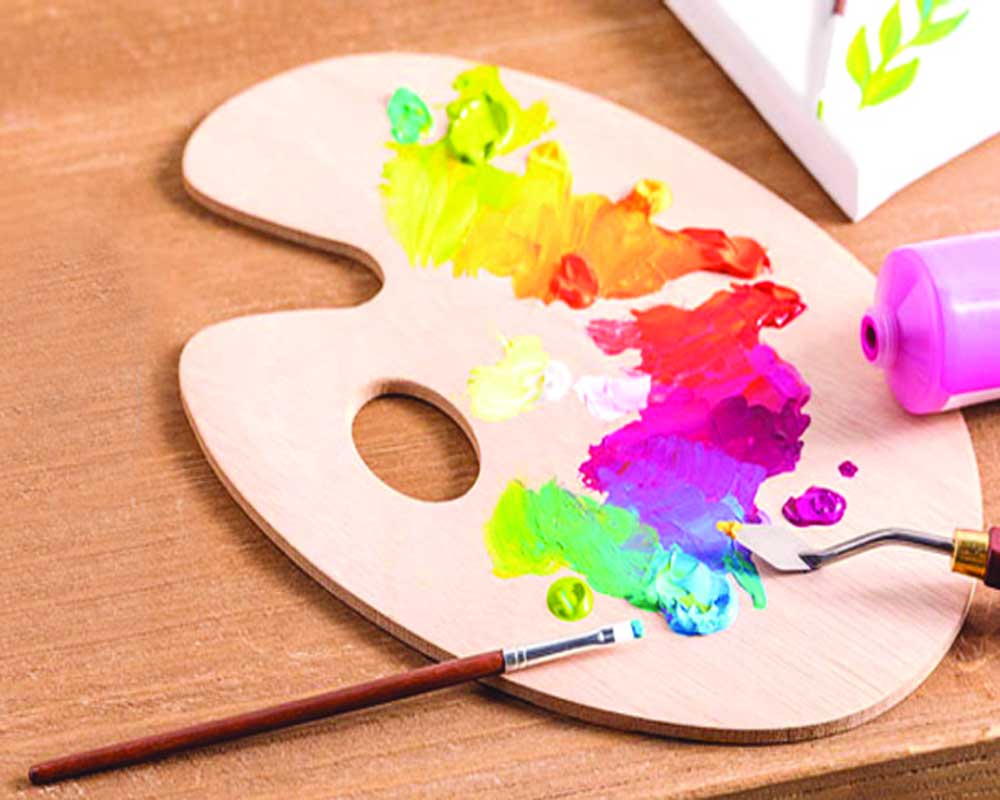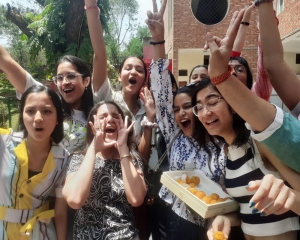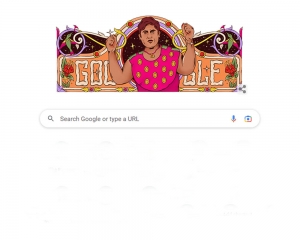A software engineer from Bengaluru, a chemistry graduate from Nashik who worked for LIC and a tailor from Patiala, all have one thing in common — are all artists par excellence having won many awards. SHALINI SAKSENA spends time with them to bring you a report
Best foot forward
SACHIN SANGHE, CHALK-LEAD SCULPTOR, BENGALURU
It all started when his teachers would make him write on the blackboard. His handwriting was good so he was made to write news headlines and notes that the teachers wanted to be written on the board. Besides having a good handwriting, it was the fact that it was legible, clear and in a straight line that introduced him to play with chalk. Meet Sachin Sanghe, a techie who hails from Mudigere, 80 km from Bengaluru, who is mesmerising people with his miniature pieces of art carved out of chalk and pencil lead.
He tells you that even as a child, he used to crave out just anything and everything on the pieces of chalk with the help of a compass that was always in his Geometry box.
“Drawing and craving things out of chalk was something that I loved and it was more of an hobby and I carved things till I was in school. I was good in sports as well. But my passion lay in engineering and hence pursued it. My hobby turned into full-time passion and somewhat of a profession only after I completed my engineering and was working with HCL. It was then that I decided to take up where I had left off to pass time when I was in Chennai,” Sanghe says who has presented his work to Prime Minister Narendra Modi — art pieces of chalk with the PM in various yoga poses and one with his mother.
The reason why he has not turned his hobby into a career path is because there are still some risks involved. He tells you that he would have make it his profession if what he does was a recognised and established art form. “Another obstacle is that I need a team. I alone can’t do much to make enough money. But this doesn’t mean that I am not looking at ways to turn it into a full-time career,” Sanghe explains who had tried to get his work registered with Guinness World Record. Sadly, he couldn’t find a category under which he could put his work.
“I explored the possibility but found that the categories were tallest, shortest and biggest. It was all related to magnitude. There was no place under which I could place my work. I got dejected and gave up,” Sanghe says and tells you that the chalk that he use for his pieces are dust-free.
The more elaborate pieces are also made from three-four piece of chalk — three to four inches in height. The only difference is that he attaches the other pieces with glue to bigger pieces of art. But he explains that in photos it looks bigger than they really are. The actual height of the art pieces are not more then a couple of inches. The tools that he uses are also not expensive.
“People ask me if the tools that I use are expensive or special. The truth is that my most trusted tool is a dissection knife that you find in the surgical box that one buys when you are in school. It was a knife that I used to dissect cockroaches with back in school. Another tool that I regularly use which I accidentally found was left behind by a senior in my room. It is a tool that dentists use — an excavator. I also use the blade from the sharpener. Then there is the screwdriver that one uses to open hard to reach places. Basically, small tools,” Sanghe says and tells you even though the art pieces that he carves are miniatures, there isn’t much strain on the eyes since he doesn’t spend more than four hours at one sitting.
“I don’t use any lens under which I sit and carve these figures. Right now, my eye sight is good. Also, even though a figure may take up to 20 hours, I don’t sit for more than three-four hours at a stretch. Also I work only over the weekends. Since the rest of the days, I am working full-time with Cisco Systems.
His work with pencil lead is something that Sanghe started in 2013. He tells you that there are certain advantages and disadvantages of working with pencil lead sculpting. “The advantage is that there is no dust while carving. Chalk is brittle, lead is not. The disadvantage is that the lead is thin as compared to chalk. Because lead is so thin, I use surgical scalpel to carve figures. For example, if one were to carve something on lead and the same on chalk, one might need to look at the art piece more closely to figure out what it is as lead is small in comparison to chalk. While, I don’t need to draw what I want to carve in a paper, I do keep a picture for reference since the lead sculpting is in 3-D,” Sanghe says who uses 6B or 8B pencil. To carve letters, he uses carpenter pencil.
To buy a lead or chalk figurine, Sanghe tells you that usually people contact him via social media. “Nowhere have I mentioned that I am in the profession of selling my art. People who are interested contact me through Instagram or Facebook. The cost also depends on the piece that they want, but it varies between Rs 4,000 to Rs 12,000. A lot of people want a Lord Ganesh or even Lord Krishna. The complexities happen when people want a portrait. The face has to look like the person. A wrong cut and the face changes. So I need to be more careful. One has to be very patient,” Sanghe says.
‘Creativity can’t be taught’
ANANT KHAIRNAR, COTTON SCULPTOR, NASHIK
Soul within human body with connection to the super soul, creates cotton sculpture. Human body is medium of creativity
— Anant Khairnar
Born in 1966, in a small town Jawhar, (Palghar district of Maharashtra), Anant Khairnar even as a child was interested in drawing and painting. He used to gather just any material lying around to create art. However, it was not till he was in college, while pursuing his bachelor’s degree in Science from Pune University that his full potential was realised.
“It was in 1987, last year of college, when there was a lot of discussion to create something new, never seen before idol for Ganesh Festival. Since I always thought of myself as an artist rather than a Science student, I was asked to give my suggestions. After much deliberation that took me three-four days, I suggested that we should create an idol of Lord Ganesh using cotton wool. This proved to be a turning point in my life,” the 52-year-old cotton sculptor says who worked in the private sector for three years before he spent his next 28 years working for LIC.
Creativity, spirituality, sensibility and captivity are the qualities of the soul within he tells you. “I am a God gifted artist. But all through my career I never gave up my passion to create. Art can be taught, but creativity is inborn. Nature has bestowed me with this unique art. I never worked under any master to learn the art. My knowledge comes from within. A divine power always directs me whenever I hit a roadblock,” Khairnar says.
To begin with he would need a base (like a wooden structure and paper) before he would start making a cotton sculpture. But, three decades down, with the technique that Khairnar has perfected, the entire sculpture that he makes today are made from a special grade of surgical gauge.
“When I made the first cotton sculpture I used cotton wool. I also needed to create a rough body before I could give the idol the final look. But with time, I have perfected my art form. Today, I don’t need a base. As long as I have a reference picture in front me, I am good to go. Also, cotton wool has been replaced with a special kind of gauge. There were two steps involved while making these sculptors. First, involves using a special combination of chemicals. Second, at the same time, pieces of surgical gauge are used to give shape to the sculpture. These chemicals play a vital role in my sculptures. They not only give shape but have sticking quality as well. The good part is that they are not volatile, hence they evaporate quickly. But weather plays spoilsport. Sometimes, I have to wait for up to a day for the liquid to dry,” Khairnar explains who has taken up his passion full-time, now that he has retired.
Over the years, Khairnar has own many awards. Limca Book of Records — 1997; Guinness Book of World Records —1999; Outstanding Young Indian Award —1999; Adarsh Nagrik Puraskar, Jalgaon —2000; Thane GauravAward, Thane — 2009 and Samaj Seva purskar, Chennai — 2015 to name a few.
His sculpture of Mahatma Gandhi which is seven-and-a-half feet tall has won him an award. He also made a sculpture of Shri Ram (12 feet tall for the Khumbh Mela) which posed some challenge to begin with due to it’s height. But he overcame that. Today, going big and tall is no longer a challenge for Khairnar who charges Rs 15,000 per foot for his work.
Though, there are a few Indian clients as well, most of his clients are foreigners. “Over the years, people have come to know about me and my work. I have a website where I share my work from time to time. I get orders as well. Since my art form is unique, only my family is involved. My son is pursuing his MS in the US. He also looks after the marketing side of my work. I see to the creative side. It takes around a-month-and-a-half to create one piece because I spend only four hours a day. Making these sculptures need a lot of patience,” Khairnar says who is now busy giving finishing the few orders that he has of Lord Ganesh idols for Ganesh Chaturthi.
Needle man paints gossamer dreams
ARUN KUMAR BAJAJ, SEWING MACHINE PAINTER, PATIALA
A visit to darzi gali in Patiala will throw up a surprise. Not because there are so many tailors but because there is a man who creates beautiful works of art using thread. He makes paintings using his trusted sewing machine. Yes, you read that right. Meet the self-proclaimed Needle Man from Patiala— Arun Kumar Bajaj.
The 36-year-old artist who is a tailor by profession tells you that he hated working in his father’s tailor shop. “I was 12 when my father said that I should accompany him to the shop and learn the trade. I hated it. At that age I wanted to go something different, something unique. I learnt embroidery. I have made so many clothes for celebrity singers over the years. All the embroidery on their clothes was done by me. Back then, I was still exploring other avenues when my father passed away in 2000. I had to shoulder the responsibility. I was only a teenager. But, I didn’t shirk from what I had to do,” Bajaj recounts.
It was fated that Bajaj got the recognition that was due to him. When he was around 20, he dreamt that he was painting a portrait of Guru Nanakji using a sewing machine. The dream was so real that Bajaj could clearly see the completed painting in front of his eyes. When he got up he was surprised that there was no such painting in front of him. But it got him thinking — was it possible to make a painting using different threads and a sewing machine?
“When I woke up, I thought to myself can I realise my dream? Or is it just something that my subconscious mind had thrown up since I wanted to be different from others and do things that nobody had done before. I thought about it and decided to give it a try. I went to my shop. I had a portrait of Guru Nanakji; I traced that on a piece of paper and then on a piece of cloth. I bought different coloured threads and began. It took me a week to complete it. Due to God’s grace my first attempt was a success. From there, there was no turning back” Bajaj recalls who has painted over 2,000 paintings. Each more beautiful and brilliant than the last.
The beauty of these portraits lie in the shading that Bajaj has incorporated. To achieve this was no mean task. “Unlike a painting when one can give shading by painting over it, giving shading using threads was a challenge. Nobody had done this kind of work before me. I didn’t have a template that I could follow. It took many trials and errors before I perfected the art of shading. Take for example the painting of a tiger that took me over two years to complete. The moss on the cave floor has so many shades that had to be incorporated to give the painting a feel that it has been made using paints and not thread,” Bajaj explains and says that usually a small portrait takes up 10-15 days to make. However, a big one may take as long as six months.
The six feet by four feet Lord Krishna portrait was made in three years using 28.36 lakh m long thread has won him the India Book of Records on February 4, 2015 and the Unique World Records on September 24, 2016. His other popular works include a portrait of Shaheed Bhagat Singh, Jesus Christ and even that of Prime Minister Narendra Modi whom he presented the painting in person.
He tells you that his recently finished thread painting of Maharaja Ranjit Singh’s darbar (4x2 feet) fetched him Rs 11 lakh. Most of his thread paintings are in the range of Rs 60,000 to Rs 4 lakh. The first thread painting that he sold was that of an old man, he tells you and adds that he has already applied for Guinness World Record.
“Almost all the formalities are over. I have submitted all the paperwork that is required. Now, they have to cross-check and see that the sewing machine that I use is not computer operated. I hope that I will get this coveted record this year,” Bajaj says.


























